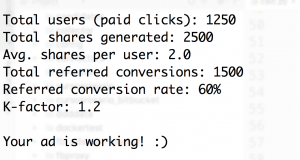Ads don’t work. Yes, they might be working for you now, but in the long run, they won’t work. Think about it. More and more advertisers (aka competitors) are joining the digital wave. More ad dollars are competing for the users’ attention. More competition means attention’s cost will increase, leading to higher CPAs. Yes, you could squeeze your dollars using an orchestrated analytics tool set. They can tell you how to save a few cents by pausing your ads at some specific hour of the day. In the long run, this won’t work either. We sometimes get caught in the digital spending frenzy and don’t realize that promoting content on the Internet is free. It is a mindset change: you can think in terms of CPA or in terms of K-factor. On the one hand, you are paying people to see your ad, click on it, and convert it into customers. In another, you are paying for people to share your ad (app, link, content), which will lead to more people seeing it, and more people converting into customers. I’m not advocating retiring your ad spend (don’t hate me, Ad agencies), but to see beyond CPA values and look at content spreading instead. K-factor is an easy way to calculate this, giving you another dimension to measure your ad’s performance. It will make you think carefully about why a potential customer shares your ad. If your Ad K-factor is above 1, it means your dollars will have a positive ROI in the long term, guaranteed. If your Ad K-factor is below 1, it is time to rethink your ad. I wrote this simple python script to give you an idea about the metrics you need to track to measure your Ad K-factor. Here is a sample output:  You can collect your ad’s clicks, track the users’ shares, and the referred conversions; put those values in the script and get your Ad K-factor.
You can collect your ad’s clicks, track the users’ shares, and the referred conversions; put those values in the script and get your Ad K-factor.
 You can collect your ad’s clicks, track the users’ shares, and the referred conversions; put those values in the script and get your Ad K-factor.
You can collect your ad’s clicks, track the users’ shares, and the referred conversions; put those values in the script and get your Ad K-factor.Latest posts by Leo Celis (see all)
- From SaaS to AI Agents - 05/27/25
- The AI Automation Engineer - 05/13/25
- Hire One Developer to Press One Key - 05/06/25